To be outside, sitting on a large flat rock, overlooking what appears to be the entire sweep of the world, on a chilly but sunny and clear mid-November Saturday morning, with a paint brush in my right hand and watercolor paints and paper on the board on my lap, all of it beckoning me to respond, is my idea of bliss. For me, it’s a natural high.
This is how I spent this morning (Nov. 13), as a new member of the newly formed group of watercolor artists here in San Miguel de Allende, Mexico, now a branch of IWS, the International Watercolor Society’s “Globe Art Network,” which has more than one hundred branches throughout the world.
Our group’s first outing, held today, was to El Charco del Ingenio, San Miguel’s own glorious botanical gardens, where we fanned out to do plein air (French for “open air”) paintings.
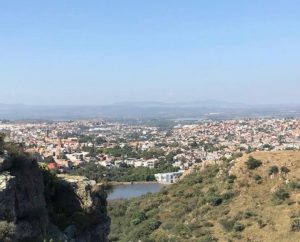
God knows I’m not an accomplished watercolor artist with years of experience, as are many of the group’s other members. If it takes 10,000 hours, as writer Malcolm Gladwell claims, to become proficient at something, I have about 9,900 hours to go when it comes to watercolor painting. Nevertheless, undaunted, I’m determined to at least keep trying.
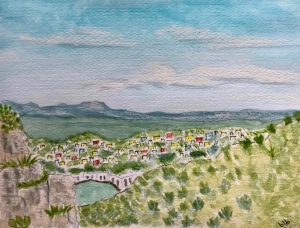
Actually, what keeps me going is the pleasure of it. The bliss. I feel an almost overpowering need at this stage of my life to take the childlike artist inside of me, whom I affectionately think of as a perennial third-grader, outside to play — with her paint set, brushes, paper, and a clear plastic jar of tap water in hand.
Of all the visual arts, watercolor appeals to me most, for many practical reasons: It’s clean (no messy and time-consuming clean-up), affordable (no need for fancy equipment or an expensive studio), and, above all, it’s utterly portable. You can easily take all that you need outdoors – in the open air! — where I most love to be.
In my historical novel, Jamie’s Muse, based on the short lives of my Scottish great-grandparents, Helen and William Black, I tell the story of a gift Helen bought for Will before he left Scotland for South Africa ahead of her in late 1881, to begin a new job as a clerk for the nascent Natal Government Railways. Her gift was a long, thin, tin watercolor paintbox, newly manufactured and popularized for amateur artists at that time.
The clerk at the store in their hometown of Kirriemuir, Angus, had lectured Helen about the virtues of watercolor. “We’ve come a long way,” he said to her, pressing her to buy the tin paintbox, “since the Egyptians made watercolor paints out of ground stone, insect blood, and fruit juices and painted on papyrus! Now anyone can paint anywhere, anytime, on white paper, with these wondrous little cakes of water-soluble colors nestled in this handy, portable metal case. … Just think, William will be able to carry it with him everywhere he goes and paint whatever he sees!”
And, in my imagination, this is just what Will did. He painted small scenes of South Africa – the port at Durban and the interior landscapes, the mountains and grasslands, the trees and birds and sun and sky — and sent them to Helen in the months before she was able to join him there. Through his simple paintings, folded and tucked inside his letters to her, she could read his mood and his growing love for the warm and sunny land that would become their new home together, however briefly.
It’s no surprise to me that my favorite visual artist of all time has been J. M. W. (Joseph Mallard William) Turner, the English Romantic painter best known for his imaginative landscapes and turbulent marine scenes. When he died in 1851, Turner left behind over two thousand watercolor paintings filled with the luminous spirit of the places he painted.
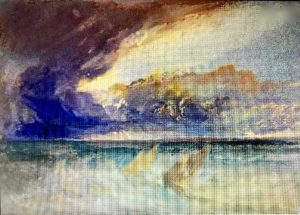
So there we were this morning, about to capture the dazzling light of Mexico on a sunny Saturday in November in San Miguel’s botanical gardens with our plein air paintings:
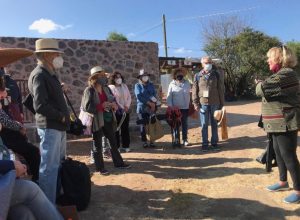
In future months this new IWS group will be doing plein air painting in other locations in and around San Miguel, where sunshine and beauty abound year-round. If you’re in the area and are interested in joining SMA’s IWS group and learning about the many benefits of membership, contact one of the local founders, watercolorist Linda Whynman at vellum1@mac.com . If you live elsewhere in the world, go to the International Watercolor Society’s website to learn about the IWS group nearest you (https://iwsglobe.org/about-us/ ).
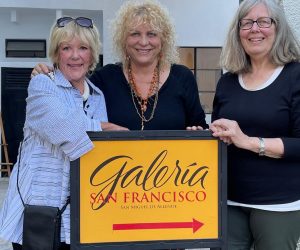
~ ~ ~ ~ ~ ~ ~ ~
If you’d like to see a wonderful and inspiring 15-minute YouTube watercolor tutorial from my newest favorite online tutor, British artist Lois Davidson, go to: https://www.youtube.com/watch?v=26B1KyP-GCQ
